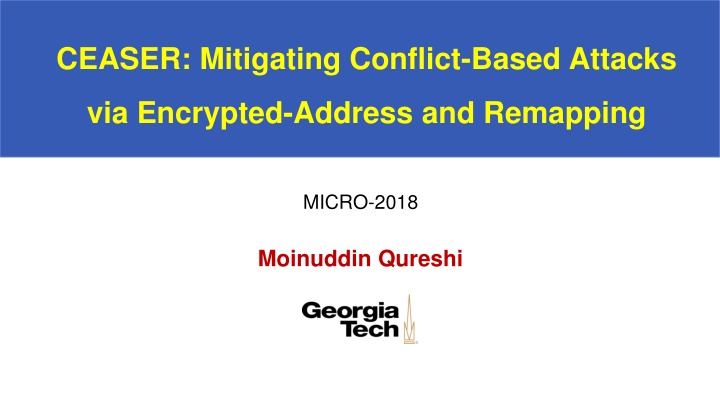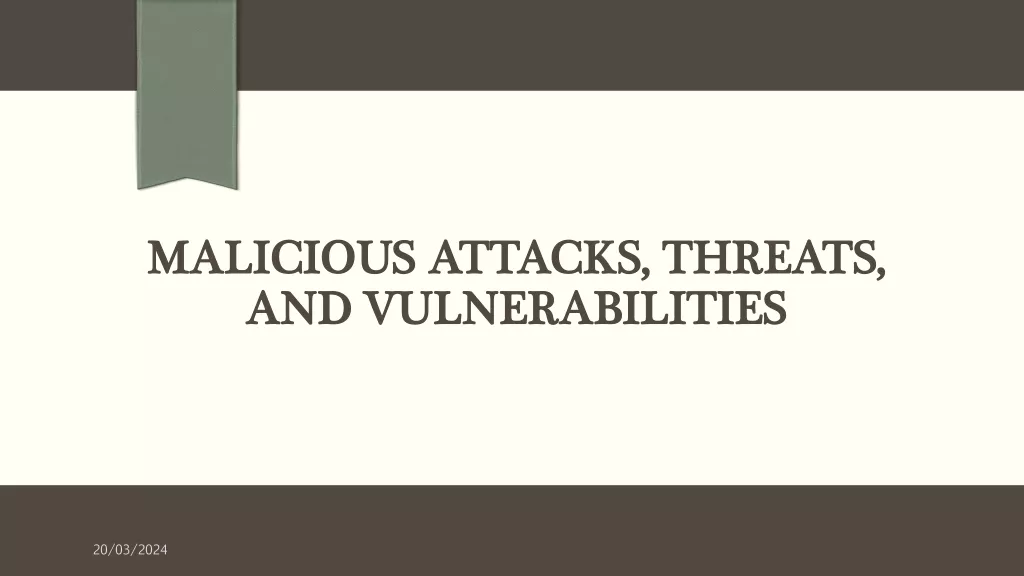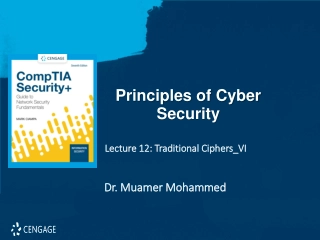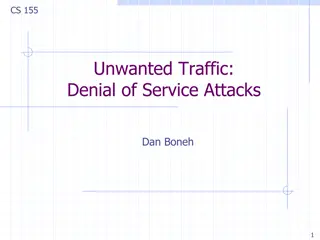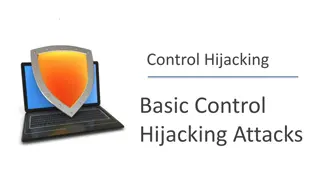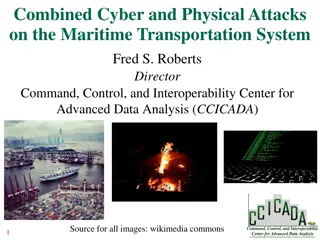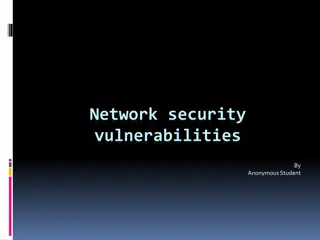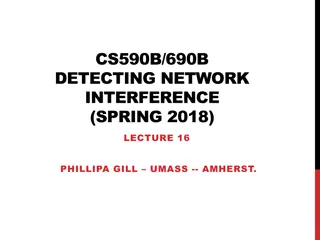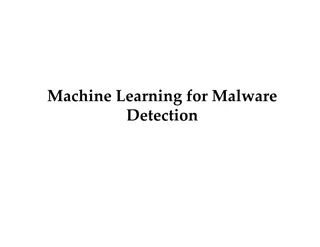Mitigating Conflict-Based Attacks in Modern Systems
CEASER presents a solution to protect Last-Level Cache (LLC) from conflict-based cache attacks using encrypted address space and remapping techniques. By avoiding traditional table-based randomization and instead employing encryption for cache mapping, CEASER aims to provide enhanced security with negligible storage and performance overhead, no OS support requirement, and unrestricted capacity sharing.
Download Presentation

Please find below an Image/Link to download the presentation.
The content on the website is provided AS IS for your information and personal use only. It may not be sold, licensed, or shared on other websites without obtaining consent from the author.If you encounter any issues during the download, it is possible that the publisher has removed the file from their server.
You are allowed to download the files provided on this website for personal or commercial use, subject to the condition that they are used lawfully. All files are the property of their respective owners.
The content on the website is provided AS IS for your information and personal use only. It may not be sold, licensed, or shared on other websites without obtaining consent from the author.
E N D
Presentation Transcript
CEASER: Mitigating Conflict-Based Attacks via Encrypted-Address and Remapping MICRO-2018 Moinuddin Qureshi
Background: Resource Sharing Modern systems share LLC for improving resource utilization B LLC CORE CORE Sharing the LLC allows system to dynamically allocate LLC capacity
Conflict-Based Cache Attacks Co-running spy can infer access pattern of victim by causing cache conflicts B B V A Miss for B Victim Accessed Set LLC CORE (Spy) CORE (Victim) Conflicts leak access pattern, used to infer secret [AES Bernstein 05]
Prior Solutions Table-Based Randomization Way Partitioning NoMo [TACO 12], CATalyst [HPCA 16] RPCache[ISCA 07], NewCache[MICRO 08] Mapping Table (MT) Mapping Table large for LLC (MBs) Inefficient use of cache space OS support needed to protect Table Not scalable to many core
Our Goal Protect the LLC from conflict-based attacks, while incurring 1. Negligible storage overhead 1. Negligible performance overhead 1. No OS support 1. No restriction on capacity sharing 1. Localized Implementation
Outline Why? CEASE CEASER Effective?
CEASE: Cache using Encrypted Address Space Insight: Don t memorize the random mapping, compute it Key Key xCAFE0000 Decrypt Encrypt Physical Line Address (PLA) Dirty Evict ELA 0xa17b20cf (ELA) LLC CEASE Localized change (ELA visible only within the cache) Cache operations (access, coherence, prefetch) all remain unchanged
Randomization via Encryption Lines that mapped to the same set, get scattered to different sets Key Key A B A B A Encrypt Encrypt B LLC LLC LLC CEASE CEASE Mapping depends on the key, different machines have different keys
Encryption: Need Fast, Small-Width Cipher B B Block Cipher PlainText CipherText PLA is ~40 bits (up-to 64TB memory) Larger tag (80+ bits) Small-width Ciphers deemed insecure: Brute-force attack on key Memorize all input-output pairs Latency of 10+ cycles Insight: ELA not visible to attacker (okay to use 40-bit block cipher)
Low-Latency Block Cipher (LLBC) Four-Stage Feistel-Network (with Substitution-Permutation Network) *inspired by DES and BlowFish Encryption LLBC incurs a delay of 24 XOR gates (approximately 2-cycle latency)
Outline Why? CEASE CEASER Effective?
Lets Break CEASE [Liu et al. S&P, 2015] Form pattern such that cache has a conflict miss D Remove one line from pattern & check conflict B C A E LLC Yes No Conflict Miss? Removed line MAPS to conflicting set Removed line NOT in conflicting set Attacker can break CEASE within 22 seconds (8MB LLC)
CEASER: CEASE with Remapping Split time into Epoch of N accesses (change Key every Epoch) Key Key Key CACHE BULK time EPOCH CurrKey CurrKey CurrKey NextKey NextKey NextKey GRADUAL CEASER uses gradual remapping to periodically change the keys
CEASER: CEASE with Remapping Remap-Rate of 1 % Remap W-way set after (100*W) accesses X1 A1 A0 B0 SetPtr CurrKey CurrKey NextKey NextKey B1 X0 Access=0 Epoch=0 Epoch=0 Epoch=0 Epoch=0 Epoch=0 Epoch=1 Access=200 Access=400 Access=600 Access=800 Access=0 Y1 Y0 Z0 Z1 Cache Access: If (Set[CurrKey] < Sptr) Use NextKey CEASER with gradual remap needs negligible hardware (one bit per line)
Outline Why? CEASE CEASER Effective?
Security Analysis Time to learn Eviction Set for one set (vulnerability removed after remap, <1ms) Remap-Rate 8MB LLC 1 MB LLC-Bank 1% (default) 100+ years 100+ years 0.5% 100+ years 21 years 0.1% 0.05% 100+ years 37 years 5 hours 5 minutes No-Remap (CEASE) 22 seconds Limits impact on missrate, energy, accesses to ~1% 0.4 seconds CEASER can tolerate years of attack (Even with remap-rate of 1%)
Performance and Storage Overheads 8 cores with 8MB LLC 16-way (34 workloads, SPEC + Graph) CEASE CEASER Norm Performance (%) 100 Structures 80-bit key (2 LLBC) SPtr Cost 20 bytes 2 bytes 99 98 97 Access Counter 2 bytes 96 Total 24 bytes 95 Rate-34 Mix-100 ALL-134 CEASER incurs negligible slowdown (~1% ) and storage overheads (24 bytes)
Summary Need practical solution to protect LLC from conflict-based attacks Robust to attacks (years) Key1 Key2 Negligible slowdown (~ 1%) Encrypt Line Address Negligible storage (24 bytes) Localized change (within cache) Cache No OS support needed Change Key, Periodically Appealing for Industrial Adoption
What About Flush-Based Attacks? Flush-Based Attack: Use clflush to evict shared line, wait, and test Partitioning Randomization Restriction SHARP [ISCA 17] Compatible with CEASER Line Duplication NewCache [MICRO 17]
Diffusion Properties of LLBC Diffusion: Single bit change in input causes lots of bits to change in output Proposed LLBC has close-to-ideal diffusion properties
Determining Set Index Cache index function determines the line to set mapping ? Proprietary Function B B Line Address Line Address Proprietary index functions can be learned [Liu et al., S&P 2015] Breaking one machine gives information for ALL other machines
